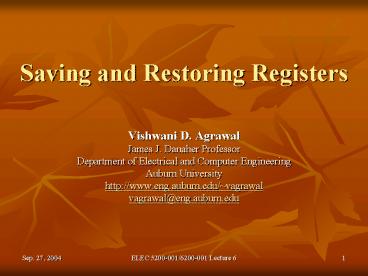Saving and Restoring Registers - PowerPoint PPT Presentation
1 / 15
Title: Saving and Restoring Registers
1
Saving and Restoring Registers
- Vishwani D. Agrawal
- James J. Danaher Professor
- Department of Electrical and Computer Engineering
- Auburn University
- http//www.eng.auburn.edu/vagrawal
- vagrawal_at_eng.auburn.edu
2
Memory and Registers
Memory
0 4 8 12 . 4n . . . 4n4k .
byte addr.
Word 0
Register 0
zero
Word 1
Register 1
Word 2
Register 2
Register 3
v0 (Word n)
Register 4
4n
v1 (Word n1)
Register 5
k
vk (Word nk)
Register 31
jump addr.
vk1 (Word nk1)
3
Data Placement in Memory
s0-s7 saved in Stack during procedure
sp
Stack
Dynamic data
gp
Static data
Machine code (text)
pc
Reserved
0
4
Register Convention
The following convention is understood and used
by all calling (caller) and called (callee)
programs.
Preserved Not preserved Saved reg. s0 -
s7 Temp. reg. t0 - t9 Stack pointer reg.
sp Argument reg. a0 - a3 Return addr. Reg.
ra Return value reg. v0 - v1 Stack above the
stack pointer Stack below the stack pointer
5
Caller Actions
- Put parameters values in argument registers, a0
- a3 - Save registers in memory
- Jump and link to calee
- Put return address (PC4) in ra
- jal calees address
- On return, restore saved registers from memory
- Find returned parameters in value registers, v0
- v3
6
Caller Saving and Restoring
- Before the call
- Push the stack pointer
- Save those temporary registers in the memory,
whose contents will be required later calee may
change these. - After the call (on return)
- Restore all saved registers
- Pop the stack pointer
7
Calee Actions
- Save any registers among s0 - s7 that might be
changed caller expects them to be unchanged. - Use arguments in registers a0 - a3
- Place results in value registers v0 - v3
- Restore saved registers from memory
- Leave stack pointer in the same state as when the
call was initiated. - Jump to address in register ra ( jr ra )
8
Calee Example
- Procedure proc uses register s0
- Assembly code
- proc
- addi sp, sp, -4 push stack down
- sw s0, 0(sp) save s0
- .
- Assembly code of proc
- .
- lw s0, 0(sp) restore s0
- addi sp, sp, 4 pop 1 word off stack
- jr ra return
9
When Calee becomes a Caller
- Saving and restoring of saved and temporary
registers is done same as described before. - May reuse argument registers (a0 - a3) they
are saved and restored as necessary. - Must reuse ra its content is saved in memory
and restored on return.
10
Example Program?Callee A?Calee B
Main program Procedure A(arg1) Procedure B(arg1)
. . addi sp, sp,
-8 sw ra, 4(sp) sw a0, 0(sp) addi a0,
zero, 7 jal B lw a0, 0(sp) lw ra,
4(sp) addi sp, sp, 8 .
. jr ra
. . addi a0,
zero, 3 jal A . .
. . . jr ra
11
Example A Recursive Procedure
Int fact (int n) if (n lt 1) return (1) else
return (n fact (n-1))
This procedure returns factorial of integer n,
i.e., n! n (n-1) (n-2) . . . 2 1 n
(n-1)! Boundary case, 0! 1
12
What to Save?
- Recursive procedure will call itself. So,
- Must reuse return address register ra
- Must change argument register a0
- These two registers must be saved.
13
Assembly Code for fact
fact addi sp, sp, -8 adjust stack for two
items sw ra, 4(sp) save return address of
caller sw a0, 0(sp) save caller supplied
argument n slti t0, a0, 1 t0 1, if n
0 beq t0, zero, L1 go to L1, if n
1 addi v0, zero, 1 return 1 addi sp,
sp, 8 no need to restore registers,
since none was changed, but
must restore stack pointer jr ra return
to caller instruction after jal
14
Assembly Code Continued
L1 addi a0, a0, -1 set a0 to n-1 jal
fact call fact with argument n-1 lw a0,
0(sp) on return from fact, restore n lw
ra, 4(sp) restore return address addi sp,
sp, 8 adjust stack pointer mul v0, a0,
v0 n! n (n-1)! jr ra return to
caller
15
Execution of fact for n 1
Call sequence Caller a0 ra v0 1 Program n
PC4 n(n-1)! 2 fact n-1 L18 (n-1)(n-2)!
3 fact n-2 L18 (n-2)(n-3)! fact . fact
. fact . n-2 fact 3 L18 32
6 n-1 fact 2 L18 21 2 n fact 1 L18 1
1 1 n1 fact 0 L18 1































